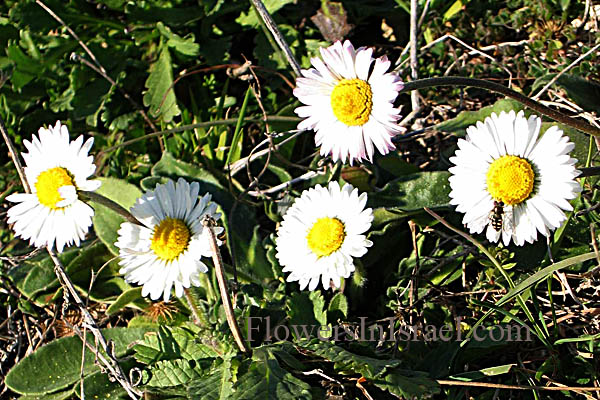Hebrew: חיננית רב-שנתית , Arabic: البليس المعمر
| Scientific name: | Bellis perennis L. | |
| Common name: | Common Daisy, English Daisy | |
| Hebrew name: | חיננית רב-שנתית | |
| Arabic name: | البليس المعمر | |
| Family: | Compositae / Asteraceae, Sunflower family, מורכבים |

|
| Life form: | Hemicryptophyte | |
| Stems: | Average height 15 cm; underground horizontal stems (rhizomes); stems sparsely to moderately covered with soft hairs | |
| Leaves: | Rosette, spatulate, one central vein without branching, slender stalks; covered with soft hairs; smooth to finely scalloped or toothed margins | |
| Flowers: | 1.5-3 cm flower head diameter; yellow center made up by few hundreds of disc florets, and white radiating petals (ray florets); purple tipped petals | |
| Fruits / pods: | One seeded, lance shaped, flattened, yellowish brown, and hairless | |
| Flowering Period: | January, February, March, April, December | |
| Habitat: | Batha, Phrygana | |
| Distribution: | The Mediterranean Woodlands and Shrublands, Montane vegetation of Mt. Hermon | |
| Chorotype: | Euro-Siberian | |
| Summer shedding: | Ephemeral |

Derivation of the botanical name: Bellis, Latin, bellus, pretty; the white daisy, ox-eye; Linnaeus: Bellis perennis. perennis, remaining or lasting throughout the year; perennial. The Hebrew word: חיננית, chenanit, a daisy, from חן, chen, grace, beauty.

|